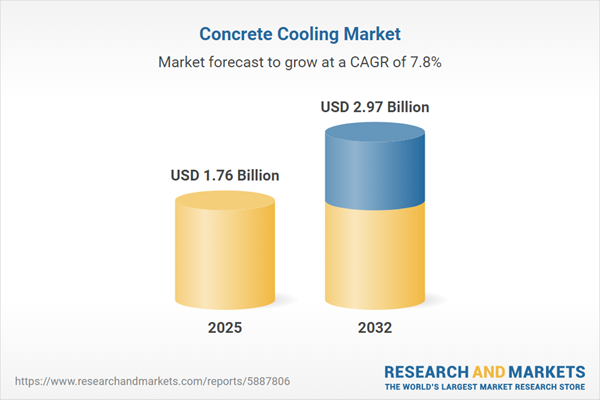Speak directly to the analyst to clarify any post sales queries you may have.
The concrete cooling market is entering a period of strategic transformation driven by changing technical requirements, sustainability imperatives, and dynamic regulatory forces. As project complexity rises and environmental responsibilities increase, advanced cooling solutions are becoming integral to the competitive landscape for construction industry leaders.
Market Snapshot: Concrete Cooling Market Growth and Trends
The Concrete Cooling Market grew from USD 1.63 billion in 2024 to USD 1.76 billion in 2025. Continuing at a CAGR of 7.75%, it is projected to reach USD 2.97 billion by 2032. This robust momentum highlights rising demand for temperature management during concrete hydration and curing, reflecting global shifts toward high-performance construction, regulatory compliance, and environmental responsibility. Growth is also linked to urban expansion, infrastructure modernization, and strategic adoption of advanced thermal management practices across commercial, industrial, infrastructure, and residential segments.
Scope & Segmentation: Concrete Cooling Market Landscape
This research delivers granular analysis, segmenting the market by end user, cooling technology, equipment type, geography, and top industry participants for senior decision-makers seeking actionable insights.
- End User: Commercial, Industrial, Infrastructure, Residential
- Cooling Technology: Chemical Admixtures, Chilled Water Systems, Ice Cooling, Liquid Nitrogen Cooling
- Equipment Type: Portable Cooling Units, Stationary Chillers
- Regions: Americas (including North and Latin America), Europe, Middle East & Africa, Asia-Pacific
- Key Countries: United States, Canada, Mexico, Brazil, Argentina, Chile, Colombia, Peru, United Kingdom, Germany, France, Russia, Italy, Spain, Netherlands, Sweden, Poland, Switzerland, United Arab Emirates, Saudi Arabia, Qatar, Turkey, Israel, South Africa, Nigeria, Egypt, Kenya, China, India, Japan, Australia, South Korea, Indonesia, Thailand, Malaysia, Singapore, Taiwan
- Leading Companies: Sika AG, BASF SE, Mapei S.p.A., GCP Applied Technologies Inc., Chryso S.A.S., Fosroc International Limited, Dow Inc., RPM International Inc., W. R. Grace & Co., MÜNZING Chemie GmbH
Key Takeaways: Strategic Insights for Senior Stakeholders
- Precise thermal control during cement hydration directly impacts structural reliability and service life, making concrete cooling central to large-scale construction success.
- Growth in high-performance concrete usage is driving demand for integrated temperature management solutions tailored to specific curing timelines and local climates.
- Sustainability goals are influencing the rapid evolution of cooling methodologies, with contractors and design teams embedding resource-efficient strategies in early project phases.
- Real-time monitoring systems and digital sensor networks support proactive risk management and operational optimization during complex builds.
- Segment differentiation is evident: commercial projects emphasize timeline efficiency, industrial facilities focus on equipment protection, infrastructure demands long-duration consistency, and residential use centers on local adaptation.
- Innovative cooling technologies such as ice cooling and liquid nitrogen methods are being deployed in challenging environments, extending options beyond traditional water-based systems.
Tariff Impact: How Trade Policy Is Shaping Market Adaptation
Recent tariff measures in the United States have altered supply chain strategies and spurred the shift toward regional sourcing and alternative material formulations. Domestic partnerships have been strengthened to remedy cost fluctuations and logistical uncertainties, while manufacturers invest in local R&D to match or exceed imported product standards. These developments are also accelerating capacity building and innovation in indigenous cooling technologies.
Concrete Cooling Market Methodology & Data Sources
This assessment combines extensive desktop research, primary interviews with engineers and procurement managers, and qualitative validation. It leverages triangulated data from procurement records, technical whitepapers, and patent filings. The approach ensures interpretation rooted in real-world applications, with iterative reviews and peer consultations for accuracy and actionability.
Why This Report Matters: Decision-Ready Insights
- Gain strategic clarity on how regulatory shifts, sustainability mandates, and new cooling technologies are converging to redefine project planning.
- Benchmark opportunities and risks across diverse markets, from urban infrastructure projects in EMEA to fast-growing high-rise construction in Asia-Pacific.
- Support procurement, risk management, and design decisions with segment- and region-specific intelligence tailored to evolving market realities.
Conclusion
Concrete cooling is now essential to competitive advantage in construction, requiring a strategic blend of innovation, collaboration, and compliance. With informed, data-driven choices, organizations can strengthen quality outcomes, mitigate emerging risks, and ensure lasting project value.
Additional Product Information:
- Purchase of this report includes 1 year online access with quarterly updates.
- This report can be updated on request. Please contact our Customer Experience team using the Ask a Question widget on our website.
Table of Contents
3. Executive Summary
4. Market Overview
7. Cumulative Impact of Artificial Intelligence 2025
Companies Mentioned
The companies profiled in this Concrete Cooling market report include:- Sika AG
- BASF SE
- Mapei S.p.A.
- GCP Applied Technologies Inc.
- Chryso S.A.S.
- Fosroc International Limited
- Dow Inc.
- RPM International Inc.
- W. R. Grace & Co.
- MÜNZING Chemie GmbH
Table Information
| Report Attribute | Details |
|---|---|
| No. of Pages | 189 |
| Published | October 2025 |
| Forecast Period | 2025 - 2032 |
| Estimated Market Value ( USD | $ 1.76 Billion |
| Forecasted Market Value ( USD | $ 2.97 Billion |
| Compound Annual Growth Rate | 7.7% |
| Regions Covered | Global |
| No. of Companies Mentioned | 11 |









